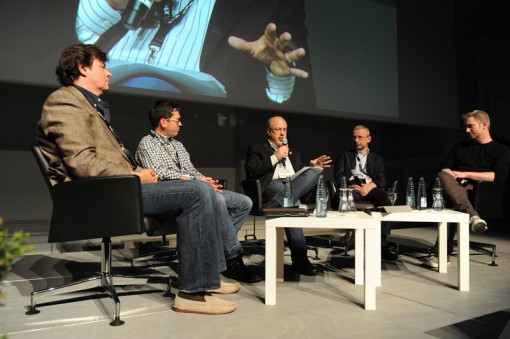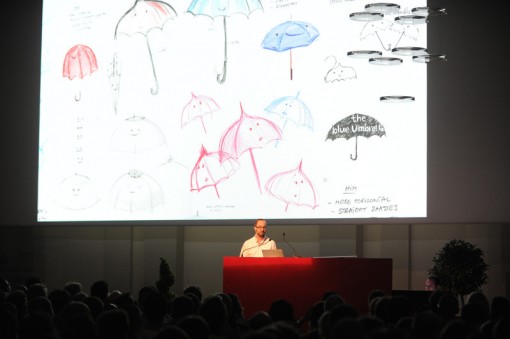FMX, Europe’s most influential conference on digital entertainment successfully concluded last Friday (April 26) drawing an international audience of professionals, innovative talents and students from 46 countries.
“Thanks to its interdisciplinary focus, FMX 2013 constituted an ideal platform to bring industry, education and research together,” commented FMX managing director Niels Rinke on this year’s success.
Of note was the sobering panel discussion on the “Future of the VFX Industry,” moderated by Eric Roth (Visual Effects Society) and featuring company heads Pierre Buffin (BUF Compagnie), Mark Driscoll (LOOK Effects), Christian Vogt (Pixomondo), and Jean-Noël Portugal (jnko). Roth described the industry in a word: contradiction. The use of vfx has been growing and becoming the center of the entertainment universe as a major company like Rhythm and Hues fell apart.
The panelists agreed that the state of the visual effects industry posed many challenges and was in desperate need of new business models. Look Effects’ Driscoll said the industry was unhealthy and struggling to figure out its place.
“We need to change our methods … to allow the industry to grow,” he said.
Roth raised the possibility of a trade union as a solution. The question was met with some skepticism and uneasy laughter from the group.

Pixomondo’s Vogt said a union would only work if all countries were involved.
“If there were a union, it must be on a global scale.”
Otherwise non-participating countries would undercut it.
Driscoll added, “A global union is not going to happen.” Countries would have to agree on a standard pricing mode. “It would be a monumental task.”
He went on to say what needs to happen first is changing the conversation about where vfx is placed, from service providers to creative contributors to the project—in other words, as producing partners.
Digital Domain CEO Ed Ulbrich echoed a similar perspective in his “New Business Models in the VFX Industry” keynote address. He presented a concise view as to why the current relationship between vfx companies and studios creates a hostile working environment, often due to lack of compensation for a director’s innumerable changes or if a film has been placed on hold or canceled after the company has already staffed up. Then, he called on the industry to align their interests with producers and behave as “digital production companies.” However, he added, “This is easier said than done.”
Ulbrich and the other panelists were cautiously optimistic about the industry’s future. They agreed the demand for vfx was only growing thus allowing opportunity for those willing to take it.

“We can look at this as a time of great doom and gloom or great opportunity, especially for the entrepreneur,” Ulbrich said.
Capturing the Paradigm Shift
The conference’s “paradigm shift” track included several intriguing talks from Games for Change Europe, an organization that creates and distributes social impact games that serve as educational tools about topics like ecology, human rights and oppression. Curated and hosted by Games for Change, Europe co-president Katharina Tillmanns, she described the organization’s mission as looking at games as a way to create meaning with media by engaging players through game mechanics to tell a story, inform and change behavior.
Their recently executive produced Facebook game Half the Sky Movement: The Game addresses the oppression of women in third world countries. What started as the #1 New York Times best-selling book Half the Sky: Turning Oppression into Opportunity for Women Worldwide and a critically acclaimed documentary, the game is the latest installment in the drive to raise awareness on this important topic. A charity aspect was integrated in the game, inviting players “to be a part of the solution.” The longer the game is played the more money is donated by a sponsor to aid women in developing countries.
“We aren’t necessarily good world hippies, but see games as a good tool to communicate ideas,” Tillmanns said, wryly.
Hollywood studio projects were represented in full force. Animation keynote speaker Saschka Unseld, director of the delightful new Pixar short The Blue Umbrella, previewed the film to a packed audience. The Hamburg-born artist described being inspired by the sight of a broken, discarded umbrella on the sidewalk. He stepped through the process of how to “take an idea or feeling and shape it into a film” and how story development gave “visual form to an emotion.”
Munich-Los Angeles based Trixter presented a visual effects case study for its entertaining digital character animation work on the “metal” suits for Iron Man 3, followed by Weta Digital’s case study into how its VFX contributed to the storytelling in the movie’s climatic battle sequence. Later in the week, Markus Manninen, vfx supervisor of DreamWorks’s feature The Croods, presented a behind-the-scenes look into the movie’s artistry and technical workflow.

Running commensurate with FMX was The Stuttgart Festival of Animated Film. About 1,000 of the best animated projects worldwide were featured, representing the gamut of genres. Each evening culminated in an outdoor public screening in the Schlossplatz, the town center. The unseasonably warm weather attracted over 7,000 people a night, who picnicked while watching such animated films as Tim Burton’s Frankenweenie and Aardman Animation’s The Pirates! Band of Misfits dubbed in German. It was heartening to experience the local community supporting the lively event. One ministry official said government funding of cultural arts projects like the festival were necessary. Otherwise, they would no longer exist. Too bad the U.S. government arts funding policies do not share the same approach.




 Win a Funko X Lilo & Stitch Prize Pack!
Win a Funko X Lilo & Stitch Prize Pack!

